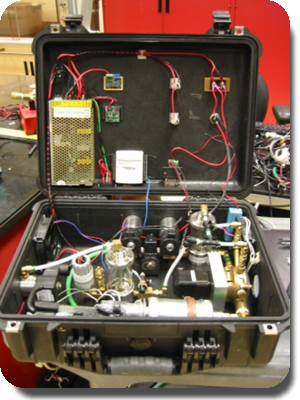Hydrogen-fueled Auxiliary Power Units (APUs)
21 states and many additional counties and cities have enacted anti-idling laws for heavy duty diesel trucks. These rules range in severity from a limit of 5 minutes to 15 minutes, depending on the location. The laws are meant to reduce the amount of exhaust particulates generated by the engine when it is used solely to provide cabin comfort for the driver when he is resting or sleeping. A typical cabin layout (shown above) includes heater, a/c, computer, microwave and other accessories. Penalties have been high and frequent.
Fleet owners and Owner/operators are choosing a variety of solutions for complying with the anti-idling laws. Many companies are installing deep discharge marine batteries on their trucks to provide power to the cabin during mandatory rest periods. Other operators are installing small generators that utilize diesel fuel. Cummins is developing a fuel cell coupled with a diesel fuel reformer. All of these approaches achieve compliance with the law, but are inefficient and generate additional CO2 emissions.
Silverthorn Solution:
Silverthorn is developing a hydrogen on demand fuel cell APU (prototype shown right). Hydrogen is generated from a silicon-based compound, a catalyst and water captured from the exhaust of the truck while it is operating on the road. There are no fugitive emissions and no CO2 is produced. The fuel cell operates at much higher efficiencies than small engine generators and much more efficiently than the alternator on the main engine when charging marine batteries.
- The APU system is even more attractive when combined with Silverthorn’s Hydrogen-assented Diesel Exhaust Aftertreatment System. With this system, the hydrogen generating system is already available. The hydrogen can be piped to a hydrogen fuel cell to make electricity when needed.
- The market for this product is primarily the long haul heavy duty diesel truck. There are over 500,000 trucks in this type of service in the U.S. alone. These trucks require 2kWh APU support 8 hours per day, 300 days per year.

